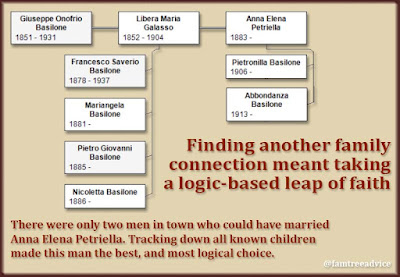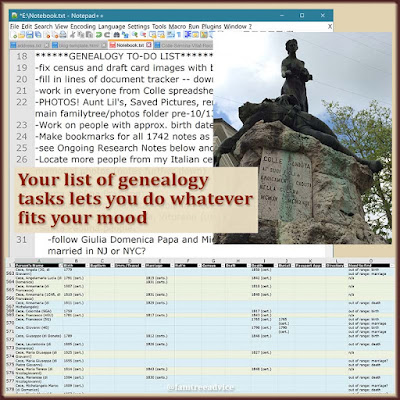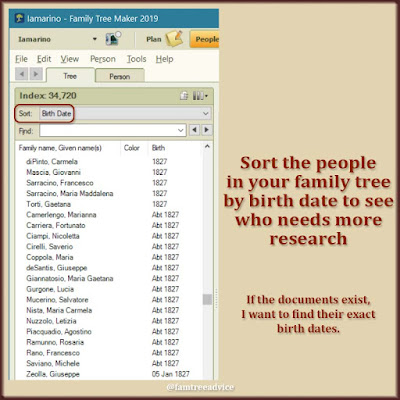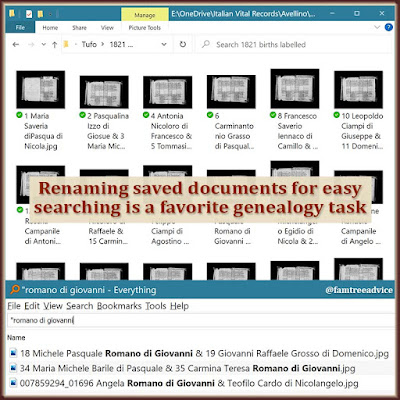UPDATED ON 29 MAY 2024. By now, everyone should be comfortable with the November 2021 redesign of the Italian Portale Antenati—the ancestors portal. The site's managers have been making changes behind the scenes, and the website is working better than ever.
No one should still be upset about the redesign of Antenati.
Why They Changed the Website
There was a time when the Antenati site went down almost every day. Since the change, only once did I find the site unavailable. That's a huge improvement.
The redesign makes site maintenance easier for their team—no doubt. It's a huge website! The homepage on 29 May 2024 says its contains:
- 85 provincial state archives
- 1,725,481 register books
- 139,159,506 images.
As a 25-year website maintenance veteran, I get why the Antenati team wants to make their lives easier. Now let's make your life easier.
Adapting to the Changes
Creating Source Citations. Every Antenati document in my family tree had a source citation that became obsolete with the change. However, the old image URL you saved before November 2021 now redirects you to the same image at its new URL. This is fantastic, and I believe it's because we requested it so loudly.
Here's one of my old-style source citations:
From the Benevento State Archives: http://dl.antenati.san.beniculturali.it/v/Archivio+di+Stato+di+Benevento/Stato+civile+della+restaurazione/Baselice/Morti/1856/199/007850708_01745.jpg.html
You can see from the old URL itself that the document is from Benevento, from the town of Baselice, and from the death records for 1856.
 |
| Your new Antenati documents need a new style of source citation. Here's my template. |
My new Antenati source citation format is this:
From the xxx State Archives, YEAR TYPE, TOWN, document xx, image xx of xx at book url; image URL
I keep that text (and so much more) in my Notebook.txt file that's always open on my computer.
Using the same image as an example, I'd change:
- "xxx State Archives" to "Benevento State Archives"
- "YEAR TYPE, TOWN" to "1856 nati, Baselice"
- "document xx, image xx of xx" to "document 65, image 35 of 41"
- "book url" to "https://antenati.cultura.gov.it/ark:/12657/an_ua757415/wWK9rlj"
- "image URL" to "https://iiif-antenati.san.beniculturali.it/iiif/2/wWK9rlj/full/full/0/default.jpg" (Find out how to get the individual image URL below.)
Altogether, the new source citation is:
From the Benevento State Archives, 1856 nati, Baselice, document 65, image 35 of 41 at https://antenati.cultura.gov.it/ark:/12657/an_ua757415/wWK9rlj; https://iiif-antenati.san.beniculturali.it/iiif/2/wWK9rlj/full/full/0/default.jpg
This format gives you all the information you need to go see the document for yourself, online or in person. It includes the province, town, and specific book; the URL of the register book; and the URL of the high-resolution image of the document.
Navigating Smartly. Getting to the register book you want is easier than it was before the redesign. We used to click a province, click a time period, click our town, click a document type, and click a year. That got you to the right collection of images.
Now I start at the homepage and enter the name of the town I want. Then I can narrow down the results. Maybe I want only birth records. I can scroll down the town's results page and click Nati below the Tipologia heading. Then I can either scroll through the years or click Espandi below the Anno heading, and choose my year.
Note: I always view the site in Italian. If you haven't figured out that Anno means year and Nati means birth, you need to get grounded. The FamilySearch wiki is a great resource for learning Italian genealogy words. Memorize a few words and make things much easier.
Now that you're looking at the register you want, the best thing to do is look for the index pages. To do this, you need to use the thumbnail view menu. Here's how:
- Looking at your register book, click what's meant to be a page view icon on the right (see #1 in the image below) and choose "Right" to display thumbnails on the right or "Fondo" to display the thumbnails across the bottom. (You can even choose "Galleria" in that same menu to see nothing but thumbnails, which I realized today.)
- Scroll through the thumbnails and click any one to jump to that image.
 |
| Once you know what and where to click, the new Antenati site is easy to master. |
Zooming in to Read. The index and documents will be too small to read. To zoom in on any image, simply click the image! Click it again to zoom in further. I didn't realize this until 1 April 2022 when they released the 1950 U.S. Census on the NARA website. They use an almost identical image viewer, and I found you can simply click the image to zoom in.
Getting the High-Resolution Document Image. They must not want us to find and download the high-resolution images like we used to. Why else would they make it so tough to get to them?
While it is an inconvenience, I've turned this process into a habit. Now it's second nature for me to get the high-resolution document image I want.
 |
| Getting the vital record you need from the new Antenati website takes a few more clicks. Don't worry! It'll become routine after a few tries. |
Start by going to the page you want within any register book. As you click from page to page, you should notice that the last section of the URL (after the last slash) in the address bar of your web browser changes with each page. Copy that last section and paste it into this URL that you will keep in a safe place, replacing only the word TARGET:
https://iiif-antenati.san.beniculturali.it/iiif/2/TARGET/full/full/0/default.jpg
For example, I'm looking at a document and the URL ends in 5K6QgbP. If I paste that into my template URL, replacing the word TARGET, I get https://iiif-antenati.san.beniculturali.it/iiif/2/5K6QgbP/full/full/0/default.jpg. If you click that link you'll see the document all by itself. You can click the image once to enlarge it. And you can right-click and save that wonderful high-resolution image to your computer.
I like to leave all the browser tabs open until I complete my source citation. Copy the register book URL, the image URL, and the page number in the register.
Adapting and thriving. It's easy enough once you get used to it, and we're still getting a free resource that's intensely valuable. Remember:
- Gather source citation details as you go.
- Use the hidden thumbnail page navigator to get around.
- Zoom in by clicking the image once or twice.
- Paste the end of the URL into your template URL and save that high-resolution image.
The old website was no picnic. Make this one work for you!
The reason I decided to update this article on 29 May 2024 is the name-search feature. When you go to the Antenati site, the homepage lets you search by town (Località) or by name and town (Nome, Cognome, Località). Only recently have I had decent success in searching by name. It can be a tremendous time-saver—especially when you're searching for someone in a large city.
When you're looking at either a list of available register books for a town, or at an individual register book, see if there's a page icon. A page icon is a small graphic that looks like a printed page with its corner folded down. When you're looking at a list of available registers, the words Atti collegati are beside the icon. When you're looking at a register, the words Nominativi collegati are beside the icon.
These words and the page icon tell you this register is searchable by name! Take advantage of that. The search results list may be long, so pay attention to the details of each item in the list.
Personally, I'm eternally grateful to everyone responsible for the Antenati website. It is a godsend to every genealogist with Italian ancestry.
Be sure to also read How to Use the Online Italian Genealogy Archives.
And speaking of Italian vital records:





